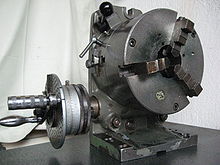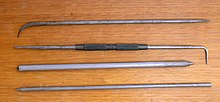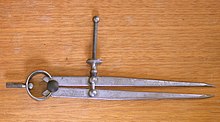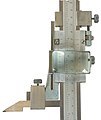Scribing
When scribing attaching is dimension lines or drilling points on a workpiece surface designated by scribing or drawing.
principle
Dimensions for holes, cuts and other processing are applied in the form of engravings or drawn lines on the workpiece made of wood , metal or stone . It is also used to “convey” shape outlines in coarser cast and forged parts and in manual flame cutting processes . The marking is carried out with a pen , chalk , a scriber or a caliper.
Pens and chalk are used, among other things, when scratching the surface must be avoided (damage to the surface or cracking due to the notch effect). Sensitive surfaces or those that should not be damaged can be covered with easily removable paper on which the pencil tear occurs.
Sometimes the attached tear lines are supplemented with punch marks in order to be able to reliably identify them after various processing operations in which the lines become increasingly indistinct. Large workpiece outlines are marked with a double punch (two closely spaced tips) along the scribe line.
In order to make the crack on metallic surfaces more visible, special dark, copper sulphate-containing lacquers or aqueous solutions (outdated: copper vitriol ) are applied to the workpiece before marking and thus - after drying - the bright metallic cracks are highlighted. In practice, a waterproof pen is often used instead of a marking color. Wet-applied whiting chalk is also possible if coarse parts with greater inaccuracy are used.
The marking by tracing an applied contour (template) onto the work piece is carried out as described above. An already high production state can be projected onto the workpiece using a template. Occasionally, pantographs are used to transfer the contours on the same, larger or smaller scale .
The marking must also be carried out taking into account the following manufacturing process . For example, it must be determined whether or not the crack on the finished part must still be present when sawing.
The achievable accuracy of the scribing is approximately 0.1 mm.
Tools
All scribing tools are part of metal technology . You can find them mainly in workshops with small series and one-off production, but also in the toolmaking of large companies. In order to achieve a reasonable durability (metal technology: tool life ) and a recognizable scratching effect on the workpiece, these tools are hardened or have a tip made of hard metal .
Drawing pins are also sometimes used in woodworking. The Japanese woodworker, on the other hand, prefers a special knife ( shirabiki ) in order to create particularly precise lines on wooden surfaces that are important for further processing.
Scriber
It is made of steel, steel with a hard metal tip or brass. Typical scriber pins are about 20 to 30 cm long and have a diameter of about 3 to 4 mm. They are usually very long pointed on both sides, with one end angled by 90 degrees after about 3 cm. The point angle is approximately 15 degrees. Typical models have a handle in the middle made of an approximately 10 cm long, knurled piece of pipe . Other variants include ballpoint pens with a hard metal tip or a simple, elongated needle.
Drawing compasses
The drawing compass is a compass that has metal points like a drawing pin. Drawing dividers are used to mark out circular arcs. The tips must be of the same length and touch each other when the thighs lie flat.
Height marker
Height markers or parallel markers are used to mark out auxiliary lines that run parallel to the contact surface of the height markers. Height indicators consist of a heavy base on which a stand with a scale is attached vertically . The stand is enclosed by a vertically movable unit that works with vernier or digitally, the scriber of which can still be adjusted horizontally using two screws . Height indicators without a scale are set using a standard measure.
- Height marker
with analog vernier
Marking gauge or scribing caliper
The so-called mark gauge and the scribing caliper is a mixture of caliper and parallel scraper. Marking lines are used to draw scribe lines parallel to a tool edge.
Tools for scribing
Marking table or marking plate
Marking plates serve as a support for workpieces and as a reference plane when marking out. Marking plates have a very flat surface. They are made of gray cast iron or granite . Scribing plates do not show any bulges when damaged and thus retain a high level of evenness . Marking tables sometimes stand on three legs so as not to wobble on uneven floors.
So that the scribing line runs absolutely straight, height gauges are made on the scribing plate. In order to facilitate the guidance of the parallel marker, graphite is scattered in flake form on the marker table.
If necessary, workpieces are aligned with bases, parallel bars, prisms, rulers and angles and spirit levels on the marking plate.
Marking plates must not be used as a storage space for tools and workpieces or as a straightening plate in order not to damage the marking plate.
Many scribing tables are equipped with a so-called scribing machine. Marking machines are 3-axis movable stands. Nowadays the three axes are equipped with an axis measurement system. The axis positions are displayed via a measuring counter. The axes are either moved manually using handwheels or by motor. The workpieces are marked out with exchangeable marking tools such as scriber or drawing compasses.
Dividing apparatus

The dividing head is a device that allows components to be rotated repeatedly by precise angular dimensions and to fix them in place for the scribing process and further processing.
Marking angle
Scribing angles are devices that make it possible to determine existing angular dimensions on components and to transfer these angles to other components for marking with a scriber.
Centering angle
With Zentrierwinkeln the centers can be determined from circular cylindrical workpieces by repeated marking.
Geometric determination and testing with the scribing method
- Geometric solution methods
With scribing lines in the work preparation before or between work steps, z. B. determined and identified on various machines, measurement points and levels on workpieces. More complex classical methods of geometry are also used (e.g. determination of a perpendicular or an exact right angle between two tear lines without a scribing table).
If a height measure and an additional side measure are attached to an upright workpiece and the workpiece is placed on its side, the exact intersection of both measures results. Similarly, with a prism in the case of turned parts, by attaching three lines at the same height, after rotating the turned part in the prism by approximately 120 degrees, the height dimension and the axis of rotation used can be checked or precisely identified.
disadvantage
Scribing pins and scribing knives can create a notch on the material surface which, despite their small size , can trigger notch effects / notch effects that can destroy the component through vibrating loads . This is especially true for soft materials such as aluminum and its alloys . In aircraft construction, scriber pins are therefore not permitted and are replaced by special pins that cannot scratch or notch the surface of the material.










